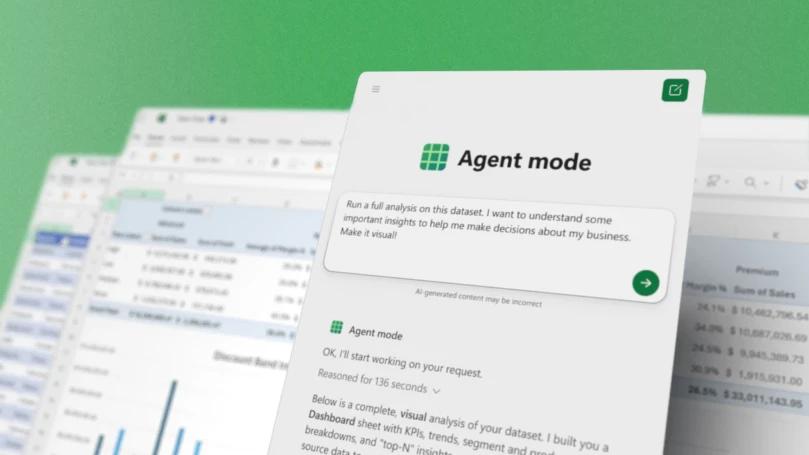With a new set of Microsoft 365 features, knowledge workers will be able to generate complex Word documents or Excel spreadsheets using only text prompts to Microsoft's chat bot. Two distinct products were announced, each using different models and accessed from within different tools—though the similar names Microsoft chose make it confusing to parse what's what.
Driven by OpenAI's GPT-5 large language model, Agent Mode is built into Word and Excel, and it allows the creation of complex documents and spreadsheets from user prompts. It's called "agent" mode because it doesn't just work from the prompt in a single step; rather, it plans multi-step work and runs a validation loop in the hopes of ensuring quality.
It's only available in the web versions of Word and Excel at present, but the plan is to bring it to native desktop applications later.
There's also the similarly named Office Agent for Copilot. Based on Anthropic models, this feature is built into Microsoft's Copilot AI assistant chatbot, and it too can generate documents from prompts—specifically, Word or PowerPoint files.
Office Agent doesn't run through all the steps as Agent Mode, but Microsoft believes it offers a dramatic improvement over prior, OpenAI-driven document-generation capabilities in Copilot, which users complained were prone to all sorts of problems and shortcomings. It is available first in the Frontier Program for Microsoft 365 subscribers.
Together, Microsoft says these features will let knowledge workers engage in a practice it's calling "vibe working," a play on the now-established term vibe coding.
Vibe everything, apparently
Vibe coding is the process of developing an application entirely via LLM chatbot prompts. You explain what you want in the chat interface and ask for it to generate code that does that. You then run that code, and if there are problems, explain the problem and tell it to fix it, iterating along the way until you have a usable application.
For certain kinds of simple applications, you can generate something usable this way. However, it often falls apart completely as you scale to more complex applications, and in any case, it's almost definitely going to introduce problems that you are less likely to see than if you wrote the application yourself, leading to (among other things) deep technical debt.
Again, that's probably fine if you're just making a simple website for your small local business or something like that. But there's consensus in the development community that it's a dangerous path to walk at enterprise scale.
If you're "vibe working" or "vibe writing" in Microsoft Word, you're doing the same thing, but with a text document: you're telling it what you want the document to say, reading it, accepting the suggestion, and then asking for further changes until you're happy with it.
Whether this makes any sense obviously depends on what kind of document you're writing. For some things, it should be just fine as long as someone is reading it as it goes. Others probably won't work for their intended purpose without a human touch. Same with PowerPoint presentations.
Doing this with a spreadsheet could be riskier, though; the financial or legal consequences for bad math or data in spreadsheets of some types can be very high, and as with vibe coding, it might be hard to see the problems at surface level.
That's exactly why Microsoft hasn't been as aggressive in adding AI features to Excel as it has with some other applications. And to be fair, it acknowledges an important gap here: a SpreadsheetBench sheet in today's announcement notes that Copilot in Excel Agent Mode managed a 57.2 percent score, while a human typically manages 71.3 percent. So as with vibe coding, you'd want to be highly selective about when and how you'd use this, and you'd want to make sure that an experienced human is auditing the output carefully.
But the thinking is that just because it's not suitable for every kind of spreadsheet doesn't mean it doesn't make sense to have an easy-to-use option for lower-stakes work.
Use with care
It's possible these tools (and refined successors) will make life just a little bit easier for knowledge workers, but as always, those workers are going to need to understand some basic principles of how LLM-based tools work, and what their strengths and weaknesses are, to make intelligent decisions about when to try and save time by "vibe working" and when not to.
All that said, a big reason why vibe coding is popular is because it allows inexperienced developers (or people who are not really developers at all) to bypass a knowledge gap; not everyone knows all the syntax and nuances of a programming language, much less which functions are available to call in a given library and so on.
Something akin to that may also be true of professional-caliber writing, but the gap doesn't seem as big there, so some may feel that "vibe working" is an answer in search of a problem.
OpenAI and some other major AI companies are said to be working on their own productivity tools built on their models, so we can also see this as Microsoft's attempt to stay ahead of the puck and make sure it doesn't find itself outscored by upstarts.

 New Warzone mode inspired by BO4’s Blackout officially confirmed
New Warzone mode inspired by BO4’s Blackout officially confirmed